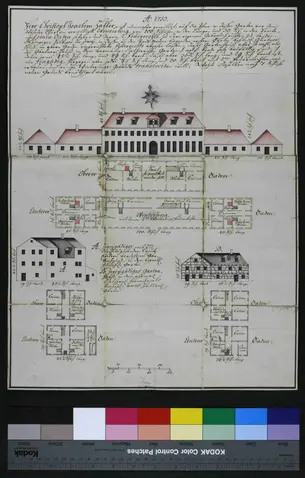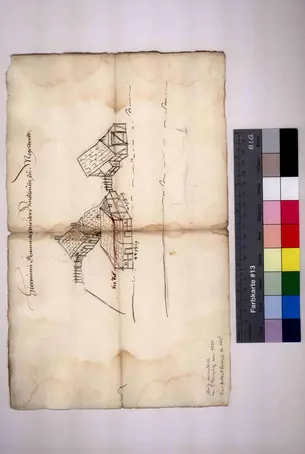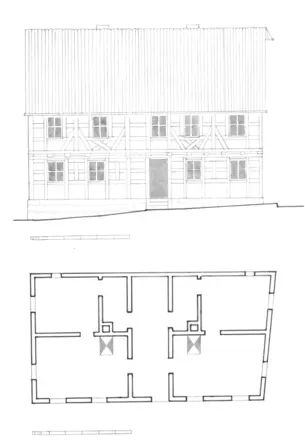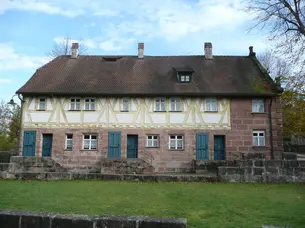Tenement house and apartment before 1800
Content and aims
In professional circles, the old houses, which today are often architectural monuments, are referred to as "farmhouse" or "burgher house". This creates the idea that our ancestors in pre-industrial times were all farmers or burghers, in any case lived in their property, no matter how large or small such a residential building. Even the burghers and peasants were not a homogeneous group, which sometimes serves as an explanation for the heterogeneous stock of old buildings. Almost completely forgotten, on the other hand, seems to be the fact that in addition to the class of homeowners, whether in the city or in the countryside, there was a segment of the population that did not own their own homes but had to rent accommodation on a permanent basis. Since there is and was an interplay between demand and supply, a third group, the tenement house, existed alongside the "peasant's house" and the "burgher's house," and not just since the "tenement houses" of the Gründerzeit. The old dual conceptual pairing is brittle and template-like, for the tenement house not only existed alongside the peasant's house and the burgher's house, in many cases tenements were even an integral part of a house occupied by the peasant or burgher himself. What term actually fits the houses in small towns, where the burgher was at the same time a farmer and also had his house full of tenants? Is it a tenant farmer's house or a tenant farmer's house?
The aim of this work is to present the development and spread of the rented dwelling, or the tenement house, as an example for a selected area in the course of modern times. The focus is on the history of architecture. The study is intended to show the importance of tenement building even before the industrialization of Germany in the 19th century. For this reason, the work begins with an examination of population figures and statistics. Since research in this area has been rudimentary to date, an attempt is made to gather as many figures as possible on tenant households in the study area. The data obtained are neither spatially nor temporally complete and for this reason can only be transferred to other regions with reservations. Nevertheless, a clear picture emerges from the many individual figures: In many parts of Franconia, whether urban or rural, renters made up a notable share of the total population.
In addition, social and economic history research findings are considered where possible, but the results from these areas are generally summarized only briefly.
Questions:
- What is the absolute proportion of the rental population from the 16th-18th centuries?
- Does the proportion of the rental population remain constant over the centuries?
- How is the rental population distributed in the rural area, are there settlement centers?
- From which social and occupational groups do the tenants come?
- What is the proportion of subtenants within the rental population?
- How many people live in an apartment or house?
- How is rental housing different from owner-occupied housing?
- How is rental housing expressed structurally?
- Can typologies about rental housing and rental houses be identified/formed based on the sources?
- Does the form of rental housing change from the 16th-18th centuries?
- Do structural peculiarities of tenement housing exist that allow classification as tenement housing/tenement housing beyond written sources?
- What do rental dwellings look like in detail?
- How is life lived in a tenement?
- What size and what comfort did the rental dwellings offer?
- What building materials, construction techniques, and design methods were used?
- Did they differ in construction methods from other rural housing?
- Can the results be applied to other regions?
Methodology
With regard to the architectural-historical focus of this work, the floor plans of the individual residential units and buildings as well as the building structures are in focus. In addition, spatial, or urban, structures are also included.
An important part of the investigation refers to the research of the used building materials and building techniques. Since the village craftsmen mainly lived for rent, in this case the executors are identical with the inhabitants.
The research is complemented by the development of related archival sources. This has proven indispensable in order to unambiguously identify a building as a tenement, and probably also touches on a crucial point as to why architectural history research has so far paid so little attention to the subject of early tenement housing: Only on the basis of a sufficient number of clearly identified tenements can this building task be discussed scientifically at all. Without the appropriate linking of the building stock with archival information, however, many rental buildings remain unrecognized in their historical function and misunderstood in their structure and essence.
Current publication
Mietshaus und Mietwohnung auf dem Land – Entwicklung, Verbreitung und Typologie am Beispiel des Nürnberger Umlandes, 1500-1800 (Univ. Diss., Erlangen Nürnberg 2018). Expected to be published July 2019.
Typenhaus und serielles Bauen in der Barockzeit – Der Erfolg des „Erlanger Hauses“. In Onnen, Elke/ Spohn, Thomas (Hrsg.): „Die neuen Häuser in den neuen Städten. Neurungen im Hausbau unter dem Einfluss der Landesherren und ihrer Baumeister zwischen 1650 und 1830. Expected to be published autumn 2019.
Pictures
Click on the images to enlarge.




